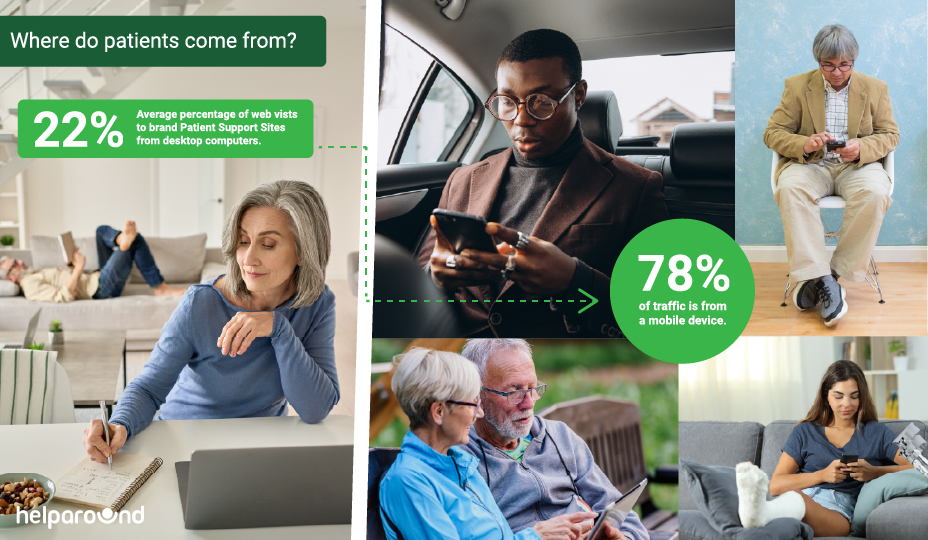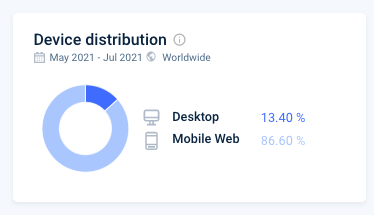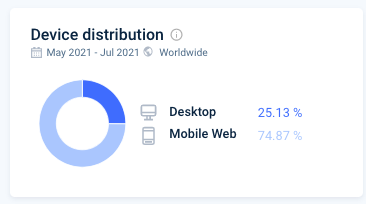Pop quiz: How do you think most of your company’s patients are accessing your patient services?
You’ve been told by “the experts” that once a patient has a prescription in hand, they go home and access your patient services in the same old predictable way.
They’re logging onto their desktop computers from the quiet of their homes. Maybe they are checking out the co-pay card or looking at the glossy PDF brochure about “The Top Ten Things to Know” about their condition. And, of course, they’re printing out the enrollment documents, signing them, and faxing them back.
A lot of classic, common-sense options–so where do you believe most patients are accessing your PSP?
Reality check: the answer is none of the above. Only a minority of your patients, about 20%, are accessing your PSP from the desktop at their home as we’ve come to expect.
Where do the other 80% access your PSP? Everywhere. When they’re at the doctor’s office, sitting in the waiting room. When they’re in an exam room, waiting for the doctor. When they’re checking out from the doctor’s office. When they’re walking back to their car in the parking garage. When they’re riding the bus or being driven back home.

The only common denominator of all of these places is this: patients are accessing your patient services on their phones. Regardless of the demographic, your patient’s lives have moved online and that life is now lived through the smartphone or tablet.
This is why PSPs need to be, first and foremost, mobile. Patient access to your programs is all about being accessible to where the patient is. And where that patient is in 2021 is all about mobile devices and connectivity.
As an example, let’s analyze two blockbuster drugs from major manufacturers. Using third party data from Similarweb, you can immediately see the importance of accessibility:
Otezla by Amgen
Based on a 3 month analysis during 2021, only 25% of the traffic to the Otezla brand website came via desktop computer. The other 75% of traffic came from patients accessing the company’s PSP via the mobile device.
Taltz by Eli Lilly and Company
During that same period, an analysis of Taltz’s branded site showed quite similar results with only 13% of traffic coming from a desktop browser. On the other hand, a whopping 87% of Taltz’s traffic came from patients accessing the company’s PSP via the mobile web.
Overall stats across the pharma industry show that is not the exception but the rule. Consistently we are seeing almost 80% of the people accessing patient support programs websites are coming via mobile web. On average, only 20% of patient traffic to access PSP sites is via traditional channels of a desktop computer.
In this new world of closed or limited doctor visits, the way patients interact with your program is online. If patients don’t find it easy to access your PSP website, your company’s ability to improve patient onboarding and adherence is limited. And accessibility is the make-or-break key to your PSP.
It’s time to ask yourself the hard question: is your specialty pharma company focusing enough on access? Are you truly maximizing mobility?
Responsive web pages aren’t the answer
Optimized access for your patients doesn’t come from creating responsive web pages for your patient services. This simply isn’t enough.
A recent study reported by Novartis analyzed 26 websites across the pharma industry to understand bounce rates. The study found high bounce rate levels across the board, on average a 65% bounce rate, with 14 websites reporting bounce rates of over 70% and 6 websites over 80%. These are sky-high bounce rates, meaning that users are not engaging with content and they’re leaving after viewing one page of a site. The same study found that average session duration was also low, as was the number of pages viewed per session.
Most pharma companies have a long way to go with regards to improving digital customer engagement and experience, in part because these companies aren’t thinking about a user experience beyond the desktop. What value is a PDF to a patient on a mobile device? Is your navigation forcing users to jump from site to site? You must anticipate the next step for each patient’s journey on their phones.
Apps aren’t the holy grail
Poor web engagement can’t be fixed by an app.
Studies show that in the U.S., fewer users are downloading apps than ever before. At the same time, people are uninstalling apps at a higher rate than ever. Pharma companies that build the entire onboarding and patient engagement experience around apps do so at their own peril.
Also read: Apps are Ruining the Patient Experience
Mobile-first connectivity is the future
It’s time for pharma to focus on not just having a mobile experience, but truly making their patient connectivity mobile-first.
Being mobile first is about so much more than just a smaller screen. You can take advantage of connections to a patient’s mobile wallet, calendar, and contacts, making information easily digestible and usable directly on a mobile device. Sending a PDF to a mobile device where it is hard to view is essentially worthless, but saving a copay card directly to the mobile wallet so they always have it with them is priceless.Also, leveraging the camera on the device can make uploading insurance cards, receipts, and even external symptoms far simpler than the desktop to scanner experience.
Connectivity is key
When looking at a patient journey, how many different websites, phone numbers, and SMS codes are patients getting information from? Connectivity to all the patient journey silos makes it easy for the patient to track their progress from start to finish, from one user interface.
Denied copay? Send patients directly to a digital PAP process instead of making them switch from digital to a phone call. Successfully obtained copay? Offer the patient a continuous process to apply to a patient support program using the same information the patient already entered for copay, making the process delightful instead of painful.
We know where your patients live; on their phones. You can choose to meet them where they are, or wait eternally for them to find you at the location that works for you, not them.
Adjusting to the new reality of PSP success isn’t a mystery; it’s a process of gearing your program around mobile access and connectivity. Let us show you how.
